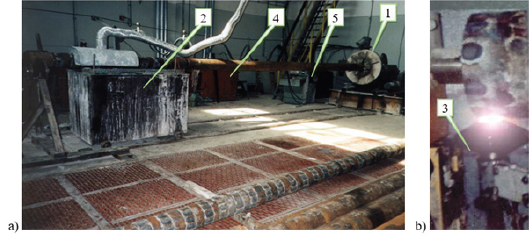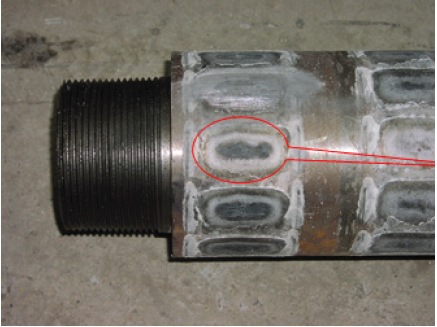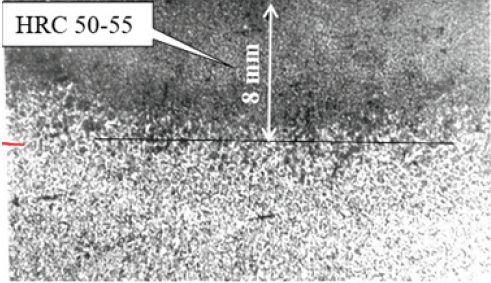- Submissions

Full Text
Aspects in Mining & Mineral Science
Efficiency of the Hardening of Drill Pipes (Rods)
Tyurin YN*
Institute of Electric Welding E O Paton, Ukraine
*Corresponding author: Yu N Tyurin, Institute of Electric Welding E O Paton, NASU, Kiev, Ukraine
Submission: October 12, 2020;Published: July 22, 2021

ISSN 2578-0255Volume7 Issue1
Opinion
Electrolyte-Plasma Thermo Cyclic Hardening (EPTCZ) is proposed, where an electric current is used, passed through a layer of plasma adjacent to the surface of the product. The technology creates a system of solid inclusions on the surface of products that reduce wear and ensure the formation of compressive stresses. The hardness of local areas on the surface of products made of 35HGSA steel is 50-55 HRC, 40X steel - 55-60 HRC, 65G steel - 60-68 HRC, 1...10mm thick. Experiments have shown that EPTSZ significantly reduces surface wear, increases bending resistance by 30...40%. The performance of the drill pipes (rods) after quenching has increased 2...3 times. The technology of creating local solid inclusions on the outer surface of drill pipes (rods) has been developed. Strengthening is carried out by an Electrolytic-Plasma Thermo Cyclic Quench (EPTCZ). The process of EPTCZ pipes is carried out on installations, (Figure 1) having a rotator-1, a tank with electrolyte-2, electrolyte heaters-3, an energy converter-4, and a control panel-5. The product (pipe) is fixed to the manipulator. An electrolyte heater is brought under the product, which is included in the electrical circuit as an anode. The product is a cathode. The electrolyte from the tank is pumped into the heater and closes the electric circuit between the electric electrode (mesh anode) and above the product through an electrolyte (aqueous solution of salt). The electrolyte heater is mounted in the tank. The heater is attached to the tank walls by means of a special bracket, which provides electrical isolation and height adjustment. Heating of local areas of the surface of the product is carried out by electric energy, which is converted into heat at the border with the electrolyte (aqueous solution alkali).
Figure 1: a) Installation for EPTCZ drill pipes (rods), b) Electrolyte heater.

The transformation of electric energy into heat is in a thin layer adjacent to the product. The capacity of this layer is two orders of magnitude lower than that of the electrolyte jet, which makes it possible to maintain in it a high the spiciness of the electric field, up to (0.5....1) 106V/m and to provide the formation of microarc. The energy of the micro-arcs evaporates the electrolyte and heats the surface of the product. A layer of plasma is formed on the surface of the product. The plasma-forming material is a water-based electrolyte. The same electrolyte is used to cool the heated surface areas. Processing can be carried out simultaneously with 2...6 electrolyte heaters. The technology allows changing the heating and Martensitic transformations in local volumes (Figure 2 & 3) increase their volume, which creates compressive stresses in the surface layer of the pipe and increases the resistance of its bend by 30...40%. This makes it possible to recommend the use of EPTSZ for hardening of products that work at high bending loads, for example, drill pipes. Comparative industrial tests of heavy drill pipes (rods), after EPTCZ, were carried out on SBSh-250 drilling rigs. The tests showed that the technical resource of the hardened rods was 3000- 4000 running meters, which is 2-3 times higher than that of the unhardened ones.
Figure 2: View of local solid inclusions on the pipe surface.

Figure 3: Section of a local solid inclusion.

Conclusion
The creation of a system of solid inclusions on the surface of products provides a multiple increase in wear resistance (2...3 times) and bending resistance (by 30...40%), which makes it possible to use EPTCZ to strengthen products that are operated in an abrasive environment at high bending loads e.g., drill pipes (rods). EPTCZ technology is versatile, environmentally friendly, energy efficient and delivers a power density of up to 3x103W/cm2. EPTC is used to harden parts of mining machines operating under abrasive wear conditions.
© 2021 Tyurin YN. This is an open access article distributed under the terms of the Creative Commons Attribution License , which permits unrestricted use, distribution, and build upon your work non-commercially.
 a Creative Commons Attribution 4.0 International License. Based on a work at www.crimsonpublishers.com.
Best viewed in
a Creative Commons Attribution 4.0 International License. Based on a work at www.crimsonpublishers.com.
Best viewed in 







.jpg)






























 Editorial Board Registrations
Editorial Board Registrations Submit your Article
Submit your Article Refer a Friend
Refer a Friend Advertise With Us
Advertise With Us
.jpg)






.jpg)














.bmp)
.jpg)
.png)
.jpg)










.jpg)






.png)

.png)



.png)






